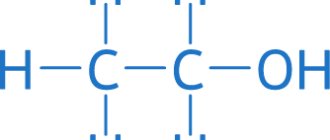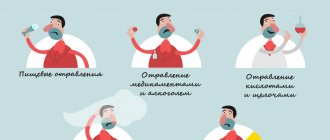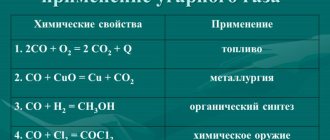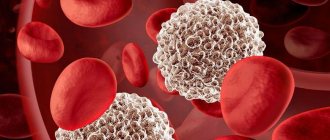Food poisoning is a pathological condition that occurs as a result of consuming low-quality, spoiled foods contaminated with pathogenic microorganisms and their waste products. The disease is not contagious, which means it is not transmitted from one person to another.
Most often, poisoning is caused by bacteria of the E. coli group, clostridia, staphylococci and salmonella.
Types of poisoning
Depending on the routes through which the poison enters the human body, scientists distinguish:
Inhalation poisoning
With this method of poisoning, toxic substances enter the bronchi and lungs with inhaled air.
Inhalation drugs include:
- poisoning by vapors of acids and alkalis;
- carbon monoxide poisoning;
- ammonia poisoning;
- household gas poisoning;
- chlorine poisoning;
- mercury vapor poisoning.
Similar poisonings are possible at chemical industry enterprises, metallurgy and other industries. Providing first aid in case of gas poisoning or toxic fumes at work, when there are many victims, is carried out in special protective equipment.
In everyday life, people more often suffer from carbon monoxide or natural gas leaks. First aid for carbon monoxide poisoning is to take the victim to fresh air!
Contact poisoning
In this case, toxins enter the body through the skin or mucous membranes.
Contact poisonings include:
- pesticide poisoning;
- fluoride salt poisoning;
- benzene poisoning;
- petroleum product poisoning;
- formaldehyde poisoning.
First aid for poisoning is as follows: the victim should be immediately removed from the area affected by the toxic substance, remove his clothes, remove the poison from the skin with a cloth or cotton wool, and wash the toxic substance from the skin with running water and soap.
Poisoning due to an insect, animal or snake bite
The poison enters through a skin defect (bite, wound). The first thing to do in case of poisoning at home is to place an ice pack on the bite site; if a limb has been damaged by the bite, then a venous tourniquet is applied above the bite site to reduce the spread of poison through the bloodstream.
Oral poisoning (by mouth)
Such poisonings include:
- food poisoning;
- alcohol poisoning;
- drug poisoning;
- mushroom poisoning;
- chemical poisoning.
First aid for poisoning should be started at the first signs of intoxication.
Gastric lavage and siphon enema are performed. If the patient is unconscious, in case of poisoning with caustic substances, lavage is carried out through a gastric tube.
The most common cases are household poisoning, food poisoning, alcohol poisoning and mushroom poisoning. The nervous, respiratory and digestive systems of the body are most affected by the effects of the toxic substance. Providing first aid for poisoning is aimed at stopping the effects of poison on the body.
The main condition for first aid in case of poisoning is emergency hospitalization in intensive care or toxicology departments, where antidote therapy and artificial detoxification are possible.
Main symptoms of poisoning
When poisoned food enters the body, toxins enter the intestines, and from there through the mucous membrane they penetrate into the systemic bloodstream, causing clinical manifestations. The following symptoms are observed for food poisoning:
- Dyspeptic syndrome (nausea, vomiting, diarrhea).
- Weakness, malaise, decreased performance.
- Paleness of the skin.
- Increased heart rate and respiratory movements.
- Reduced blood pressure.
- Pain in the abdominal area.
- Increased body temperature.
In severe cases, the development of visual disturbances, the appearance of hallucinations and disturbances of consciousness (stupor, stupor, coma) are possible. If emergency assistance is not provided to the patient in such a situation, death is possible.
First aid for food poisoning
In case of food poisoning, the “culprits” are most often foods contaminated with pathogenic microbes or containing microbial toxins. The source of infection can also be water contaminated with bacteria.
Symptoms of poisoning develop quite quickly - from half an hour to several hours after eating.
What to do in case of poisoning?
It is necessary to clear the stomach of the toxic substance as soon as possible. This can be done before the ambulance arrives, by washing the stomach with 1-2 liters of boiled water or a weak solution of potassium permanganate, and giving an anti-poisoning gel - Enterosgel.
In case of diarrhea, it is necessary to replenish fluid loss by giving the patient unsweetened tea and salted water.
First aid if a child is poisoned by poor quality food can be provided by parents.
What can be done:
- Rinse the stomach;
- Provide plenty of fluids;
- Give Enterosgel sorbent (safe and recommended from the first days of life);
- Call a doctor.
First aid for poisoning in adults also involves taking Enterosgel sorbent, which effectively absorbs toxins in the intestines. In the absence of diarrhea, the doctor prescribes an enema or the patient is given a saline laxative to remove the toxic substance from the intestines, and detoxification therapy is prescribed.
Food poisoning: causes, signs and treatment
Food poisoning is a condition that is familiar to literally every adult. A sharp deterioration in well-being after eating is most common in the summer. In order to take action in time, it is useful to know the symptoms of food poisoning, classification, and first aid.
MedEx Clinic is a multidisciplinary medical center where you can quickly get advice from the right specialist. We employ world-famous doctors with the highest qualification categories and scientific degrees.
Causes of poisoning
Food poisoning is usually called an acute gastrointestinal disorder caused by the consumption of low-quality drinks or foods. It develops because opportunistic and pathogenic bacteria, as well as the toxins they produce, enter the body. They actively multiply, causing irritation of the mucous membrane of the digestive tract and various organ dysfunctions. In addition, in some cases, toxins are absorbed into the general bloodstream and spread through the blood throughout the body, causing disturbances in the functioning of other organs and systems.
Food poisoning is only bacterial. However, pathogenic microorganisms in food do not necessarily cause intoxication: the body of a healthy adult, as a rule, resists poisoning. In the external environment, under the influence of high temperatures and ultraviolet radiation, many of these bacteria die.
But there are also exceptions. Opportunistic microorganisms that get into food produce toxic substances. Poisoning of the body occurs under the influence of poisons already contained in food, as well as those formed as a result of the activity of bacteria in the intestinal cavity. Therefore, food poisoning is also called food poisoning.
You can get food poisoning if:
- do not follow the rules for preparing and storing food;
- do not wash your hands before eating;
- Do not protect food from flies and other insects.
The shelf life of some products is strictly limited: even 3-4 hours of violation of the temperature regime can lead to their spoilage. These include:
- cakes;
- cakes;
- pastry creams;
- barrel kvass;
- mayonnaise;
- pizza;
- cheese;
- cold smoked meat;
- salo;
- fish.
Food poisoning is not contagious. One person cannot transmit the disease to another by contacting him. But if they both eat the same spoiled product, they can get sick at the same time.
The causative agents of food poisoning are distributed unevenly in food. It happens that out of two people who try the same dish, only one gets sick. The second may not even feel any symptoms of poisoning.
Types of poisoning
There are the following groups of food poisoning, depending on the pathogen:
- staphylococcal;
- poisoning caused by clostridia;
- toxic infections caused by parahemolytic vibrios;
- food poisoning caused by waxy bacilli.
The classification of food poisoning separately considers specific toxic infections - salmonellosis, botulism, as well as poisoning of a mixed nature - enterococcus, E. coli. In addition, you can be poisoned by food containing toxins of non-microbial origin. This type of poisoning is usually caused by synthetic fertilizers getting into food or by toxins from food packaging.
Clinical manifestations
Signs of food poisoning are:
- Nausea. A sign characteristic of any food poisoning. The urge to vomit occurs because the body seeks to cleanse itself of toxic substances, therefore, at first, particles of undigested food are always present in the vomit. Moreover, during poisoning, gagging may continue even after the stomach is empty. The vomit will contain gastric juice, mucus, intestinal contents and bile.
- Increased body temperature. Accompanied by tremor, chills, and general weakness. With some types of food poisoning - for example, with salmonellosis and botulism - the temperature rises to 40 degrees. Similar symptoms are observed with intestinal infections, but they are of a different nature. The temperature for mild food poisoning may be within normal limits.
- Signs of general malaise. Microbial food poisoning in an adult can manifest itself as headaches, body aches, weakness and lethargy. These symptoms are accompanied by a decrease in blood pressure caused by loss of tone of the vascular walls. Oxygen starvation occurs, which poses a huge danger to the brain.
- Pain syndrome. Severe and acute pain from food poisoning is felt in the epigastric region and in the intestines. It is accompanied by stool disorder, and blood clots may be present in the stool, indicating the onset of necrotic changes in the intestinal walls.
- Loose stools, sometimes with blood clots. Blood in the stool during food poisoning is a sign that necrotic changes have begun in the intestinal wall.
Symptoms of food poisoning in adults also include signs of dehydration. The victim constantly feels thirsty and dizzy. The skin turns pale and becomes dry, especially on the lips.
The first signs of food poisoning become visible after a few hours, or less often after a day. The onset is acute, with severe digestive upset. The main symptoms of food poisoning usually appear in the following order:
- body temperature rises;
- blood pressure drops;
- begins to feel sick, then vomiting occurs;
- diarrhea develops - loose stools with frequent urge to empty the intestines, caused by a violation of the process of fluid absorption;
- pain and spasms appear in the intestines - due to the action of toxins on the mucous membrane;
- disturbances of protein and carbohydrate metabolism, as well as dehydration, develop.
At this stage of food poisoning, the patient should immediately seek medical help. Without appropriate measures, the body will begin to lose minerals involved in the conduction of nerve impulses. This can lead to convulsions, impaired brain activity, and loss of consciousness.
Diagnostics
Clinical manifestations of food poisoning can be confused with symptoms of other diseases. Most often, differential diagnosis is made from viral and bacterial intestinal infections. Anamnesis is extremely important for diagnosis: if poor quality or stale food is present, food poisoning is more likely. Infectious lesions begin in the intestines.
In case of acute food poisoning, there is often no time to establish the exact cause of the disease and the group of toxic infections. Therefore, doctors prescribe treatment immediately, without waiting for laboratory results. If mass poisoning is detected, an epidemiological study is carried out.
In severe cases, when the patient is hospitalized, he is prescribed standard tests: bacterial culture, general blood and urine tests. If food poisoning is suspected of severe damage to internal organs by toxins, ultrasound examinations are performed.
Treatment
Providing assistance for food poisoning begins with eliminating its causes. The victim needs to rinse the stomach by inducing vomiting. To do this, give him 1-2 glasses of warm water, then press your fingers on the root of the tongue. The procedure should be repeated until the contents of the stomach are cleared. If a child under 2 years old is sick, inducing vomiting is prohibited - it will be difficult for him to control it.
Further actions in case of food poisoning are aimed at removing the remaining toxins from the body and eliminating pathological symptoms. For this purpose, enterosorbents are used: they bind toxic substances like a sponge and remove them along with feces. The most famous drug in this group is activated carbon, although there are more effective modern analogues:
- Enterosgel;
- Smecta;
- Polysorb;
- Polyphepan;
- Lactofiltrum;
- Enterodesis.
Enterosorbents are taken after vomiting has stopped and the first actions for food poisoning have been completed. It is important to observe the dosage and time of administration. Enterosorbents can remove not only toxins from the body, but also drug residues, so it is important to maintain a pause of at least 2 hours between taking medications.
Further treatment is symptomatic. The doctor selects medications taking into account the signs of the disease: their action is not aimed at eliminating the clinical manifestations of food poisoning, but at relieving the symptoms. Prescribed:
- antispasmodics - for severe abdominal pain accompanied by cramps;
- bismuth preparations - for irritation of the intestinal wall and the need for accelerated restoration of the mucous membrane.
To restore the balance of fluids and electrolytes, rehydration therapy is carried out after microbial food poisoning. For this, the patient is prescribed medications:
- Orsol;
- Reosolan;
- Regidron.
They are taken little by little, but often - a tablespoon every 10 minutes. You can prepare the solution yourself by adding 1 teaspoon of salt, soda, and 2 tablespoons of sugar to clean boiled water.
If the patient continues to vomit or other medications do not help, intravenous fluid therapy may be given for food poisoning. For this, the patient is admitted to a hospital. With the help of droppers, solutions of glucose, sodium chloride, and Trisol are infused into him to prevent complications.
If the functioning of the digestive system does not stabilize, the doctor prescribes antiemetic and antidiarrheal drugs. The most common are Loperamide and Motilium. To normalize the composition of intestinal microflora, probiotics are often prescribed for food poisoning.
Throughout the entire period of treatment and recovery, the patient is prescribed a therapeutic diet. In the first days after poisoning, if possible, you should not eat, limiting yourself to drinking liquids. From the second day you can eat: rice porridge, biscuits, crackers, dryers. It is better to find out how to eat properly after food poisoning from a nutritionist.
Complications
Severe food poisoning can cause a number of complications:
- Dysbacteriosis. A pathological condition often associated with various intestinal diseases. It manifests itself as an imbalance of intestinal microflora and digestive disorders.
- Sepsis. In the presence of aggravating factors - smoking, alcohol abuse, weakened immunity - the intestinal wall ceases to perform a protective function. As a result, pathological microorganisms and the toxins they produce can enter the blood and cause infection.
- Infectious-toxic shock. It develops if there is a large amount of toxins in the blood. In case of severe food poisoning, infectious-toxic shock can cause paresis of vascular walls or the development of cardiovascular failure.
- Hypovolemia. A pathological condition in which the volume of blood circulating in the body decreases and cardiac output decreases. The consequences are felt in all internal organs - breathing problems, dizziness, and even loss of consciousness are especially noticeable. If it becomes acute, it can lead to death.
The likelihood of developing complications depends on the type of food poisoning, as well as the number of pathogenic microorganisms ingested with food.
Prevention
It is impossible to vaccinate against major food poisoning: poisoned or spoiled food will always pose a danger. Preventive measures consist of observing the following rules:
- Organize sanitary control at public catering establishments. It is necessary to monitor compliance with the preparation technology, as well as the storage conditions of the products and the timing of their sale.
- Regular testing of employees working in the catering industry or in contact with food and prepared meals. It is necessary to check the condition of the hands of such employees daily for the presence of ulcers and ulcers; if detected, put on sick leave. In addition, once every six months, employees of the enterprise must take tests for pathogens of toxic infections. Without obtaining a health certificate and updating it regularly, it is prohibited to work in this area.
- Compliance with personal hygiene rules. It is important to control the cleanliness of the room in which food is prepared and food supplies are stored. It is necessary to combat rodents and insect pests - potential carriers of pathogens: flies, cockroaches.
- In the kitchen, you need to allocate separate cutting boards for each type of product - meat, fish, salad. This will help not only reduce the risk of food poisoning, but also prevent particles from one dish from getting into another. After cooking, cutting boards must be scalded with boiling water.
Bacterial food poisoning can be prevented by regularly checking the expiration dates of foods, both when purchasing and at home. It is not recommended to store perishable foods for a long time even in the refrigerator, especially milk and dairy products: they should only be fresh. After the expiration date, eating them is strictly prohibited.
Monitoring the quality of your drinking water will also help reduce the risk of food poisoning. It is advisable to boil drinking water; do not drink tap water or water that has stood in an open container for a long time. It is not recommended to eat outside or on the veranda in the heat.
Treatment of food poisoning in an adult in Moscow
MedEx Clinic is a multidisciplinary medical center where you can contact if alarming symptoms appear. The general practitioner will determine the cause of the ailment and refer you to the right specialist. In our clinic you can undergo the necessary laboratory and diagnostic tests in a short time, receive an individually developed treatment regimen and quickly return to normal.
Price
| Name of service | price, rub. |
| Primary appointment with a general practitioner (examination, consultation with a candidate of medical sciences) | 3500 rub. |
| Repeated appointment with a general practitioner (examination, consultation with a candidate of medical sciences) | 3000 rub. |
| Ultrasound of the spleen | 1500 rub. |
| Ultrasound of lymph nodes (one anatomical zone) | 1200 rub. |
| Ultrasound of the salivary glands | 1200 rub. |
| Ultrasound of the pleural cavity | 1700 rub. |
| Ultrasound of the liver | 1500 rub. |
| Ultrasound of the hepatobiliary zone | 2400 rub. |
| Ultrasound of the gallbladder with determination of its contractility | 2000 rub. |
| Ultrasound of the pancreas | 1500 rub. |
| Ultrasound of the abdominal organs (comprehensive) | 2700 rub. |
| Ultrasound of the abdominal organs, kidneys and adrenal glands | 3700 rub. |
| Ultrasound detection of fluid in the abdominal cavity | 1500 rub. |
All prices are inclusive of tax deduction.
Sign up
Contact our doctor
Make an appointment
Dzhgarkava Tea Gochaevna
Therapist-cardiologist
Experience: 5 years
Read more
Alcohol poisoning
The first first aid for alcohol poisoning is gastric lavage. Thanks to this simple procedure, you can remove drunk alcohol and reduce its absorption in the stomach, thereby reducing alcohol intoxication. After cleansing the stomach of the remnants of “strong” drinks, you need to give the victim Enterosgel sorbent and place him under a blanket.
If a person is unconscious, it is necessary to urgently call an ambulance and lay him on his side - this will reduce the likelihood of vomit getting into the upper respiratory tract.
First aid for alcohol poisoning in a hospital setting involves detoxification therapy, restoring the functioning of vital organs and systems. In a good way, everyone should know what the symptoms of alcohol poisoning look like and what to do if they are detected.
The main causes of food poisoning:
• toxic infections – staphylococcal toxicosis and botulism, mycotoxicosis, mixed toxic infections, etc.; • toxic organic and inorganic substances; • violation of food production technology and improper storage, non-compliance with temperature conditions; • contamination, contamination of food with bacteria; • products that have become toxic under the influence of various factors and pesticides, nitrates, herbicides, fungicides accumulated in the peel and core of vegetables, berries and fruits; • unwashed vegetables and fruits, poor food hygiene.
An excellent environment for the growth of bacteria are multi-component salads, brawn and aspic, meat dishes, desserts with a cream base, canned mushrooms and dried fish. If you have even the slightest doubt about the suitability of foods intended for human consumption, it is better to refuse them.
First aid for mushroom poisoning
Inexperienced mushroom pickers often become victims of toadstool poisoning. Mushroom poison causes damage to the central nervous system, liver and kidneys. Therefore, first aid for poisoning with poisonous mushrooms should be provided by doctors!
How can you help a person before the doctor arrives?
After you have called an ambulance, first aid for mushroom poisoning at home consists of gastric lavage. It should be rinsed until the rinsing waters become clear. After this, you can give the victim Enterosgel sorbent.
First aid for carbon monoxide poisoning
Gas poisoning (CO) is a severe intoxication of the body, which can lead to severe damage to internal organs. According to statistics, carbon monoxide poisoning occupies a leading position among the causes of death from acute poisoning, so it should be taken extremely seriously.
Symptoms of carbon monoxide poisoning:
- Headache;
- Drowsiness;
- Chest pain;
- Redness of the skin;
- Hallucinations;
- Dry cough;
Severe gas poisoning is accompanied by loss of consciousness.
It is important to recognize these symptoms in time and start treatment at home in a timely manner!
Providing first aid for carbon monoxide poisoning
First of all, you need to take the victim out of the contaminated room into fresh air and free him from restrictive clothing. To reduce intoxication, give him Enterosgel sorbent and urgently call an ambulance.
First aid for carbon monoxide poisoning is the antidote - acizole. It is recommended to administer the drug as early as possible in case of poisoning of any severity.
Arsenic poisoning
Arsenic gets its name from its use in controlling rats and mice. Arsenic poisoning can result from an industrial accident, accidental ingestion, suicide, or homicide.
Symptoms of rat poison poisoning
- Heartbeat;
- Nausea;
- Dyspnea;
- Vomit;
- General weakness;
- Diarrhea;
- Convulsions;
- Loss of consciousness;
- Stomach ache.
Acute arsenic poisoning can result in acute renal failure. With chronic poisoning, nervous system disorders occur, skin cancer and lung cancer develop.
Chlorine poisoning
The cause of poisoning with chlorine and its compounds can be violations of safety regulations in chemical laboratories or industrial accidents when containers with chlorine are damaged.
What symptoms of poisoning with chlorine-containing substances may bother the victim? First of all, this is swelling of the eyelids, oral mucosa, respiratory tract, shortness of breath, pain in the eyes, suffocation.
Timely first aid for chlorine poisoning can prevent a terrible complication - pulmonary edema!
What needs to be done? Remove the victim from the room saturated with chlorine vapors, remove clothing soaked in poison, wash exposed and damaged skin with soap and water, wash eyes and rinse mouth. After this, you should give the poisoned person the Enterosgel sorbent and call an ambulance.
How to prevent possible food poisoning in humans?
Preventing food poisoning is very simple. It is enough to observe personal hygiene measures - wash your hands thoroughly with soap before eating, carefully follow the rules and requirements for storing and preparing food, as well as high-quality sanitary processing of all food products. Before eating food, make sure it is not spoiled. There should be no foreign odors, and the food should not be moldy.
Pay attention to the fact that most often you can “earn” food poisoning by consuming dairy products, cakes with natural cream, store-bought salads dressed with sour cream or mayonnaise sauces.
If you are going to use home canned food, make sure that there is a characteristic pop when you open the lid. If this was not the case, it is better to refuse this dish.
First aid for drug poisoning
Drug poisoning can be accidental or intentional. Poisoning in young children occurs due to the fault of adults - tablets are sometimes in a place accessible to children. In case of poisoning at home, it is advisable to find out before the doctor arrives the medicine that the victim took and induce vomiting, then rinse the stomach with warm water and give Enterosgel sorbent.
Providing first aid will help avoid disorders of the cardiac, respiratory and nervous systems.
In a hospital setting, treatment with antidotes, control of intoxication and other resuscitation techniques are carried out to restore the function of internal organs.
Treatment
Treatment of food poisoning must be comprehensive. To do this, you must follow a strict diet and take the necessary medications. You can also turn to traditional methods.
Medications:
- Activated carbon (relieves symptoms of intoxication, relieves nausea).
- Enterosgel (adsorbs toxic substances and promotes their removal from the body).
- Rehydrog (a drug for preparing a water-salt solution necessary to combat dehydration).
- Linex (normalizes the functioning of intestinal microflora).
In severe cases, it is possible to take antibacterial drugs, but they must be prescribed by a specialist.
Folk remedies are also successfully used to treat food poisoning. The most commonly used decoctions are dill with honey, wormwood, marshmallow roots, yarrow, cinnamon tincture and ginger tea.
The diet involves fasting on the first day of illness. Then you should gradually introduce oatmeal in water, boiled, pureed vegetables, weak fish and meat broths, crackers, and lean meat into the diet. Drinks allowed include dried fruit compotes, herbal teas, jelly, fruit drinks, and boiled water.
Until complete recovery, you should exclude pickles, spices, fatty and fried foods, mushrooms, sweets and various sauces from your diet.
First aid for poisoning with acids and alkalis
It is important to remember that in case of poisoning with alkalis and acids that enter through the mouth, it is under no circumstances recommended to rinse the stomach ! The mucous membrane of the digestive tract is covered in numerous chemical burns, and washing can cause gastrointestinal bleeding or perforation of the organ wall.
Toxicologists know which specific antidote to use for poisoning with alkalis and acids, as well as how to provide first aid for poisoning with chemicals, so if a toxic substance gets inside, immediately call an ambulance!
First aid for poisoning by acid vapors and other volatile substances
Inhalation poisoning, which occurs as a result of inhaling vapors of toxic substances, is considered one of the most severe types of intoxication. From the lungs, the poison quickly penetrates the blood and spreads throughout the body. Therefore, it is important to provide first aid in case of poisoning with gas and toxic vapors of chemicals. The victim must immediately be taken out into fresh air, loosen tight clothing, rinse his mouth with water or a soda solution and call an ambulance.
If a person is unconscious, it is necessary to provide the victim with a flow of fresh air, lay him down with his head elevated and wait for the doctor to arrive.
What can you eat in the first days
You can eat a few hours after the last episode of vomiting or loose stools. There are no strict recommendations: most likely, you yourself will feel when you want to eat. It is better to start with light foods: rice, bread, saltine crackers or bananas.
“One of the most proven diets is BRAT (banana, rice, applesauce and toast) - includes bananas, rice, applesauce and bread. This set contains essential microelements, fiber and is quite easily digestible. When your stool normalizes, you can switch to your usual diet,” says Alexey Olegovich.
In the first days, you should refrain from foods that increase gastrointestinal motility: drinks containing caffeine or alcohol, dairy products, as well as spicy, fried or fatty foods.
When should you see a doctor?
- if poisoning is associated with the consumption of mushrooms, sea fish or canned food (possible sources of neurotoxic substances);
- when consciousness is depressed - if a person falls into delirium, he begins to hallucinate;
- with numbness in the limbs or cramps;
- if the temperature is above 38°C for more than a day;
- when streaks of blood appear in the stool or vomit;
- if the condition does not improve after 2–3 days;
- if you have a small child who cannot be given water.
As a rule, specific treatment for poisoning is not required. It is important to maintain bed rest, replenish lost fluid volumes and gradually return to your usual diet. If the measures taken do not bring relief and your health worsens, do not hesitate to call an ambulance.
Source: whealth.ru
First aid for ammonia poisoning
Inhalation poisoning can occur during an industrial accident. In such an emergency, first aid for ammonia poisoning includes the following measures:
- Immediately remove victims from the contaminated area;
- Provide access to clean air;
- Allow the victim to rinse the mouth, throat, and nose with water;
- Rinse the skin on which the toxic substance has come into contact with running water;
- Rinse the stomach;
- Call an ambulance and the rescue service.
Thallium poisoning
Thallium is a highly toxic poison that enters the body through the skin, respiratory and digestive organs. Thallium poisoning is rare in everyday life; this poison is more often used for criminal purposes.
How many hours does it take for signs of poisoning to develop? Symptoms in adults occur within 3 hours and resemble an acute viral infection: runny nose, dry cough, diarrhea, vomiting, abdominal pain. Among the late manifestations of intoxication: hair loss, memory impairment, paralysis.










